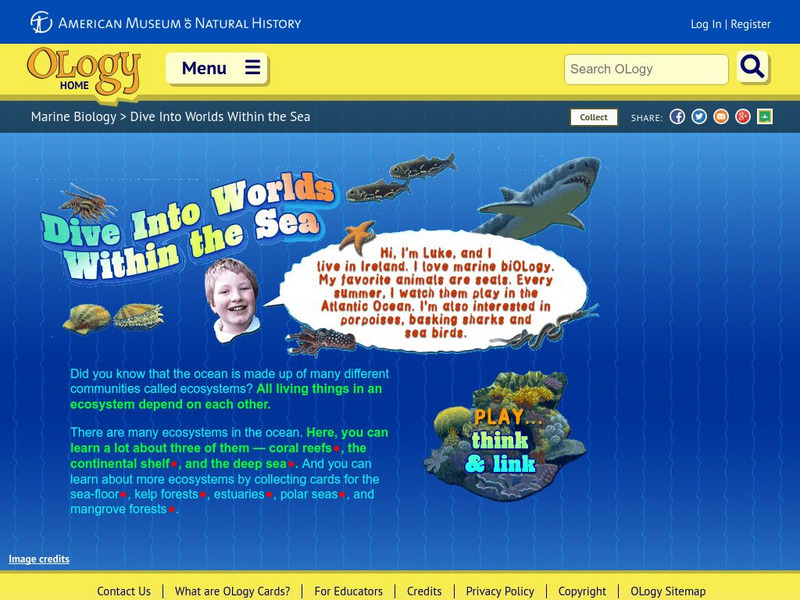Curated OER
Matter and Energy
Students investigate the effects of air pressure on humans by utilizing the Internet. In this physical science lesson, students research the Internet to discover altitude sickness and air pressure. Students prepare against...
Curated OER
Study of an Underwater Voyage
Learners examine the experiment of Lloyd Godson who lived 13 days underwater. In this critical thinking lesson, students predict, study and discuss various aspects of the underwater voyage. The lesson includes many cross-curricular...
Curated OER
Habitats and Adaptations
Students research and describe the habitat and adaptations of a reef animal. After the student is assigned a habitat, they design and draw a cresture adapted to eat each food and to live in each habitat.
Curated OER
Blowing Ballast
Oceanographers participate in a memorable hands on experience about buoyancy. They build a model of a submersible using a plastic bottle and a balloon. Afterward, they answer assessment questions. An answer key and some terrific...
Colorado State University
Does Air Weigh Anything?
Can you feel the weight of the air on your shoulders? Your classes may not believe that air has weight. A straightforward experiment asks individuals to weigh a bottle before and after adding air. Their results may surprise them!
K5 Learning
Rhyming Animals
Second graders read an informational text passage on animals, as well as a poem that incorporates rhyming words. Then, 2nd graders answer questions based on what they read.
Curated OER
How Sensitive Are The Lungs to Radon?
Pupils examine the effects of radon on the lungs. They review pictures of the lungs on a large and small scale. They work together to answer questions to complete the lesson plan.
Curated OER
Writing Quiz
In this sentences worksheet, students correct the sentences that are given to them with grammatical errors. Students complete this for 15 sentences.
Curated OER
Total English Advanced: Paradise Island 2!
In this organizing information worksheet, students read a 1 paragraph scenario and then fill in a graphic organizer with details about how they think the scenario should unfold.
Curated OER
Designing Tools for Ocean Exploration
Students explore the complexity of ocean exploration and the technological applications and capabilities required for ocean exploration. They consider the importance of teamwork in scientific research projects.
Curated OER
Air Pressure & Barometers
Fourth graders observe, measure, and record data on the basic elements of weather over a period of time (i.e., precipitation, air temperature, wind speed and direction, and air pressure). Then, they make a barometer and keep record of...
Curated OER
Density and Convection Currents
Students listen as the teacher explains convection currents in the ocean. They experiment with finding a smoking match in the classroom with their eyes closed. Students discuss what might effect their ability to pinpoint the smoke...
Curated OER
Where is That Light Coming From?
Young scholars investigate the chemistry of bioluminescence and discuss how various organisms benefit from this trait. They prepare a report about of at least one organism that receives each of the benefits discussed.
Curated OER
Twisted Vision
Learners explain polarization vision and why some animals have it while others do not. They examine the reasons why it would be helpful for marine organisms to have polarized light.
Curated OER
March of the Penguins
In this penguins video review worksheet, students watch "March of the Penguins" and then respond to 31 short answer questions regarding the movie.
Curated OER
March of the Penguins DVD Worksheet
In this movie comprehension worksheet, students view the DVD "March of the Penguins", then complete 31 short answer comprehension questions about the movie.
Curated OER
Ocean Animals vs. Humans
Students use critical thinking skills to solve word problems using ratios that allow them to compare humans to ocean animals.
Khan Academy
Khan Academy: Preventing Barotrauma in Deep Sea Divers
This passage discusses preventing barotrauma in deep-sea divers. Complete the five-question quiz on this topic.
American Museum of Natural History
American Museum of Natural History: O Logy: Dive Into Worlds Within the Sea
Learn about three different marine ecosystems: coral reefs, the continental shelf, and the deep sea. Interactive game included, which will help players chart the interrelationships among organisms that live in each ecosystem.
Science Education Resource Center at Carleton College
Serc: Dive and Discover: Expeditions to the Seafloor
Dive and Discover immerses you into the world of ocean exploration. Through stories, photos, and videos go on board research expeditions that use deep-sea tools and vehicles, and become part of teams of researchers making new discoveries.
American Museum of Natural History
American Museum of Natural History: Dive Into Worlds Within the Sea
Think and Link to investigate three different ecosystem either the deep sea, coral reef or continental shelf. By connecting the dots students make a food chain to see how organisms in each habitat depend on each other.
Other
Live Binders: Acre:snorkeling to Deep Sea Diving: Breaking Beyond Surface Reading
This unit from North Carolina Public Schools focuses on Common Core Standards for Reading including close reading strategies, questions teachers should ask themselves, and reading activities.
Other
University of Delaware: On Line Expeditions
Dive into the world of the deep sea with this website! Site includes information about the missions and discoveries made by the dive team as they explore deep sea hydrothermal vents.
My Science Site
Beneath the Sea: Blowing Ballast [Pdf]
Students dive down deep as they experience a hands-on activity and build a model of a submersible. Lesson plan includes a web connection, a teaching guide, extensions to learning as well as curriculum links and national science...






















